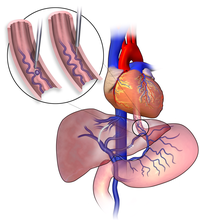
Photo from wikipedia
Purpose To evaluate the clinical outcome of patients with venous malformation (VM) involving the eyelid treated with bleomycin sclerotherapy. Methods A retrospective review was performed of 18 consecutive patients with… Click to show full abstract
Purpose To evaluate the clinical outcome of patients with venous malformation (VM) involving the eyelid treated with bleomycin sclerotherapy. Methods A retrospective review was performed of 18 consecutive patients with VM involving the eyelid who underwent bleomycin sclerotherapy. Patients’ clinical presentation, details of sclerotherapy, and post-sclerotherapy resolution of the lesion as well as any procedure-related complications were evaluated. Results Twelve women and six men of mean age 34.3±20.4 years underwent sclerotherapy with bleomycin. Chief complaints were cosmetic disfigurations with or without hemifacial deformity (n=2), pain in engorgement area (n=2), pain and swelling from venous thrombosis (n=2), swelling or engorgement obstructing their eyesight (n=2), or eyelid dysfunction (n=1). The lesions were only in the eyelid in three patients; otherwise they were extended out of the eyelid either superiorly (n=3), laterally (n=8), inferiorly (n=8), and/or posteriorly to the orbit (n=8) to various extents. Conjunctival involvement was present in 13 patients. 14 patients had received prior treatments including surgery, laser therapy, or non-bleomycin sclerotherapy. With an average three sessions of bleomycin sclerotherapy (average total dose 34.5 mg), more than 80% shrinkage was observed in seven patients (38.9%), 50–80% shrinkage in eight patients (44.4%), and 30–50% shrinkage in two patients (11.1%). One patient had recurrence, which was successfully treated again with bleomycin. No procedure-related complications were noted. Conclusions The use of bleomycin appears to be a simple, safe, and effective treatment for venous malformations involving the eyelid, avoiding more elaborate and challenging surgical or laser interventions, and is even effective in full thickness lesions.
Journal Title: Journal of NeuroInterventional Surgery
Year Published: 2018
Link to full text (if available)
Share on Social Media: Sign Up to like & get
recommendations!